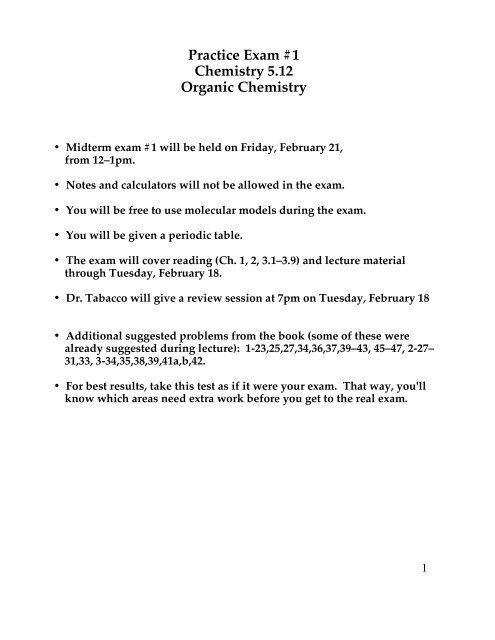Practice Exam #1 Chemistry 5.12 Organic Chemistry
Practice Exam #1 Chemistry 5.12 Organic Chemistry
Practice Exam #1 Chemistry 5.12 Organic Chemistry
Create successful ePaper yourself
Turn your PDF publications into a flip-book with our unique Google optimized e-Paper software.
<strong>Practice</strong> <strong>Exam</strong> <strong>#1</strong><br />
<strong>Chemistry</strong> <strong>5.12</strong><br />
<strong>Organic</strong> <strong>Chemistry</strong><br />
• Midterm exam <strong>#1</strong> will be held on Friday, February 21,<br />
from 12–1pm.<br />
• Notes and calculators will not be allowed in the exam.<br />
• You will be free to use molecular models during the exam.<br />
• You will be given a periodic table.<br />
• The exam will cover reading (Ch. 1, 2, 3.1–3.9) and lecture material<br />
through Tuesday, February 18.<br />
• Dr. Tabacco will give a review session at 7pm on Tuesday, February 18<br />
• Additional suggested problems from the book (some of these were<br />
already suggested during lecture): 1-23,25,27,34,36,37,39–43, 45–47, 2-27–<br />
31,33, 3-34,35,38,39,41a,b,42.<br />
• For best results, take this test as if it were your exam. That way, you'll<br />
know which areas need extra work before you get to the real exam.<br />
1
1. Circle the correct answer.<br />
a) What is the approximate H–C–H bond angle in methane?<br />
109° 120° 180°<br />
b) What is the IUPAC name for isobutane?<br />
isopropylmethane 3-methylbutane 2-methylpropane<br />
c) How much is a gauche butane interaction worth?<br />
1.3 kcal/mol 0.9 kcal/mol 4.0 kcal/mol<br />
d) What is the barrier to rotation of ethane?<br />
1.0 kcal/mol 1.3 kcal/mol 3.0 kcal/mol<br />
e) What is the pK a of ethane?<br />
4.5 50 15.7<br />
2. a) Provide line drawings for the following compounds.<br />
b) How many degrees of unsaturation does each compound have?<br />
methylcyclopentane<br />
phenol<br />
5-tert-butyl-4-ethyl-2,3,4,7-tetramethyloctane<br />
Name____________________<br />
2
3. Below is a line drawing of beryllium chloride (BeCl 2 ).<br />
a) Draw in all of the lone pairs.<br />
b) Label the atoms with their appropriate hybridization.<br />
c) What is the bond angle in BeCl 2 ?<br />
Cl Be Cl<br />
d) Draw an orbital picture of BeCl 2. Label all orbitals (bonding and nonbonding).<br />
e) Would you expect BeCl 2 to be nucleophilic or electrophilic? Explain briefly.<br />
Name__________________<br />
3
4. For each pair, circle the molecule with the lowest pK a and provide a brief<br />
explanation for your choice.<br />
Cl<br />
H<br />
H C Cl vs H C Cl<br />
Cl<br />
H<br />
CH 3<br />
N<br />
N vs CH 3<br />
H<br />
H<br />
H Br vs H Cl<br />
O<br />
H 2 C H vs H 2 C H<br />
N<br />
O<br />
H<br />
5. Provide a line drawing for the alkane represented by the following Newman<br />
projections and predict the relative energies of the conformers.<br />
Me<br />
H Me Me<br />
H Me<br />
H Me H H<br />
Me<br />
H Me H Me<br />
H Me H<br />
H<br />
H<br />
Me<br />
Me<br />
E rel = E rel = E rel = E rel =<br />
O<br />
H<br />
Me<br />
Name____________________<br />
4
6. Provide the products of the following reactions and use curved arrows to draw<br />
the reaction mechanisms. (Draw in all lone pairs and formal charges.)<br />
a)<br />
F<br />
Al<br />
O<br />
F F H 3 C CH 3<br />
b)<br />
CH 3 CH 3<br />
CH 2<br />
H 3 C H 3 C N CH 3<br />
H<br />
c) In the above reactions, which of the four molecules is acting as a Bronsted base?<br />
d) In the above reactions, which of the four molecules is acting as a Lewis acid?<br />
Name____________________<br />
5
7. a) For each pair, circle the major (lowest energy) resonance structure and<br />
provide a brief explanation for your choice.<br />
b) Draw curved arrows to convert the structures on the left to the structures on<br />
the right. Draw in any lone pairs that you move with curved arrows.<br />
O<br />
O<br />
H 3 C NH H 3 C NH<br />
H 2 C<br />
OCH 3<br />
H 2 C<br />
OCH 3<br />
H<br />
H<br />
N<br />
H<br />
N<br />
H<br />
O<br />
N<br />
O<br />
N<br />
O<br />
O<br />
N<br />
N<br />
N<br />
N<br />
Name____________________<br />
6
8. a) Both of the nitrogen atoms in A are potentially Lewis basic. Draw the two<br />
possible products resulting from the reaction of A with BF 3 . Use curved arrows to<br />
show the reaction mechanism. Show all lone pairs and formal charges.<br />
N<br />
N<br />
H 3 C CH 3<br />
b) Which product from part a would you expect to be more stable? Draw resonance<br />
structures to illustrate your answer.<br />
Name____________________<br />
7

















